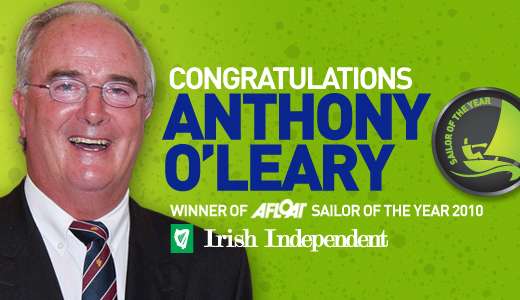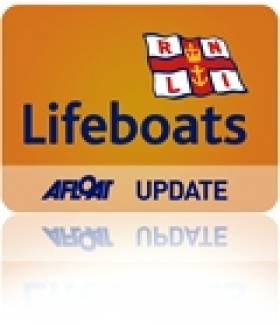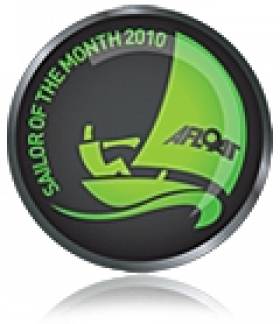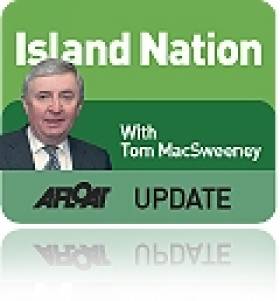Displaying items by tag: Afloat
Thanks for YOUR Comments, Keep'em Coming!
Thanks for your feedback. Each Afloat.ie posting has the opportunity to comment at the end of the story and we're keen to get as many people involved as possible. Join us on facebook, debate on the forum or simply leave a comment on a story. Here's a recent selection:
No Medals But Plenty of Confidence for 2012
I bet who ever decided to put up the "take that mr Percy" comment on the afloat Facebook page yesterday looks like a twat now.
Stephen
Jérémie Beyou on BPI wins Dun Laoghaire Leg of Solitaire du Figaro
Congratulations to Jérémie and to all the other sailors who came in this morning. Watched (from my window!) -- quite a spectacular sight and some competitors were so close after such a long race.
Toestrap o'Hike
Coveney Welcomes Funding for New Coast Guard Station in Crosshaven
Hope to have it built by the end of 2012 together with the new Goleen Station. A good year for Cork. Minister Ring will be officially opening our Achill Station on the 3rd of September. Guests welcome.
Chris
Nixon Makes History With Silver at World Junior Rowing Championships
Well done Holly and Paul. This is the result of a lot of hard work, and a successful system of support provided by Rowing Ireland, with funding by the Irish Sports Council and Sport NI.
Gordon Reid
100 Days and Counting to Race Around the World
Hi Guys, Congratulations on your coverage of the VOR, you have more information than the event website which doesn't even mention the SANYA boat.
Cahill's Joie de Vie Sails to Victory at WIORA Series, Clifden
Thoroughly enjoyed the hospitality and good company up in Clifden. Well done to the winners.
Susan Wallace
Afloat.ie - Essential Maintenance Tonight
Seven days, Seven Winners in Afloat's Facebook Competition
Cruise from Kinvara to Tahiti Wins Sailor of the Month Award
Recognised by the senior offshore sailing organisation, the Irish Cruising Club, with the award of the historic Faulkner Cup, the Quinlan's achievement is further enhanced by the fact that, in their determination to acquire a boat suitable for long distance voyaging, they built their steel-constructed 40ft cutter Pylades themselves, launching in 1997.

They have brought a lively and enquiring eye to the complex project, something which reflects Fergus's qualifications as an architect. As he has drily observed himself, there isn't a lot of work around for architects in Ireland at the moment, so everything clicked with the boat sea-tested and ready to go off on this sail of a lifetime.
Having left Kinvara in June 2009, their longterm plan is a global circumnavigation, returning to Galway Bay in August 2012. Quite what Ireland will be like by then is anybody's guess. But as it is, the crew of Pylades have enough to be getting on with in dealing with the vagaries of the open ocean, and the volatile political situation in some of the areas where ocean voyagers go. For armchair sailors at home, their thoughtful and entertaining reports on their experiences make them worthy "Sailors of the Month".
City Powerboat School on the Market
Due to an opportunity for its owners overseas Dublin City's only powerboat training school, City Powerboat School is on the market. The Irish Sailing Association recognised training establishment is advertised in next week's edition of Afloat magazine. The school operates in the 'highly visible' River Liffey area. School principal Felix Finlay says 'the position of the school in Dublin City has attracted many enquiries, for not only powerboat training courses, but sail training, tourism activities, and educational opportunities'. More here.
Outstanding Anthony O'Leary is Worthy Sailor of the Year
Anthony O'Leary of Cork is the Afloat.ie/Irish Independent "Sailor of the Year" in celebration of his outstanding achievements afloat nationally and internationally throughout last season, and to honour his dedication to sailing in all its forms both as a participant and an administrator.

The O'Leary pace afloat and ashore belies his age of 53. During 2010, it was in May that he was "Sailor of the Month" for an already remarkable list of wins with his Ker 39 Antix. Having topped the April Series in Kinsale, he then won the Crosshaven-Dun Laoghaire race overall, went on to win his class and be one of the top points scorers in the ICRA Nationals in Dublin Bay, and then went on to Scotland to win his class overall with a nail biting brace of wins on the final day of the Scottish Series.
To achieve all that before May was out was exceptional, but the O'Leary progress was only beginning. The big picture was to maintain momentum towards the international Commodore's Cup in the Solent in August. Antix was one of the three boat squad, and her skipper was also the team captain in a campaign which was light years away from the glossy efforts which dominated the boom years of Irish affluence.

Anthony O'Leary takes on the waves at the helm of his yacht Antix during Cork week in Cork Harbour. Photo: Bob Bateman
In previous seasons, Ireland had been able to muster enough boats for two or even three teams, yet had never won despite being within inches of success. But this time round, only three boats were game for it, and only one – Rob Davis's Corby 36 Roxy – was new. Yet with Dave Dwyer's ever-keen Mills 39 marinerscove.ie filling the third slot, O'Leary headed a potent force, and he himself sailed with style and inspiring sportsmanship to give Ireland a commanding overall win.
Anthony O'Leary is the personification of Irish sailing at its very best. With the enthusiastic support of his wife Sally, he is father to a family which has logged outstanding sailing success at all levels. Yet he himself is in many ways the quintessential club sailor. He is as happy racing the Autumn series at Crosshaven with a 1720 or the West Cork regattas with a cruiser-racer, as he is competing at the highest levels. He has been among the front runners for the title of Ireland's "Sailor of the Year" several times. And now, as with all his wins, when he does do it, O'Leary does it with style.
Rick Tomlinson Addresses 'Sailing By the Lee' Luncheon
Today's 'Sailing by the Lee' lunch in Cork in aid of the RNLI featured guest speaker Rick Tomlinson, the Round the World Photographer who hails from the Isle of Man.
The lunch began with a drinks reception sponsored by The Electric Bar and Restaurant of South Mall.
Tomlinson gave a 40 minute slide show that featured a selection of Antarctic images including maginificent wildlife photography. It was immediately clear to the 200 guests that not only does this photographer have a great eye but also a strong techincal ability, his shots ranging from 360 degree fisheye to telephoto lens shots taken from helicopters.
As always it was a packed attendance at the Maryborough hotel for the start of season function, organised by Kinsale's Susie Elliott. This years lunch included host RNLI Governor Peter Crowley, sailmaker Des McWilliam, Afloat.ie's Claire Bateman, Vinnie O'Shea, commodore of SCORA, Gary and Susan Horgan of Sovereigns Cup, Race officer Alan and Mary Crosbie and many, many more. Scroll down for photos (by Bob Bateman) below!
During the lunch, Peter Crowley paid a special tribute to Rick on his remarkable career, "I wish to acknowledge Rick's absolute dedication; commitment and enthusiasm in representing those connected to the sea, in bringing the thrills and excitement of the Volvo Ocean Race back to us at home and capturing the ongoing challenges and adventures of the international maritime community. Rick has also been most important to us over the years, as through his work, he has also captured with his talents the volunteer life saving work of the RNLI."
Rick Tomlinson is best known for capturing the Southern Ocean at its most treacherous from the decks of various yachts in the Whitbread Round the World Race/Volvo Ocean Race. Born in 1958, Rick grew up on the Isle of Man, where he established a serious interest in sailing. Rick's enthusiasm for photography began while he was boatbuilding and sailing. Yacht racing aside, Rick has extended his skills into expedition and project photography to such places as the Arctic and Antarctic, Chile, Alaska, Caribbean and Africa, together special assignments for the RNLI.
Speaking at the event, Kinsale RNLI Fundraising Secretary Susie Elliott stated, "It has been a remarkable year for Kinsale RNLI. Having opened our boathouse just over a year ago, we continue to work to raise the funds needed to meet the construction costs. Our sponsors and supporters for this year's event have been extremely generous and we are very grateful to them, particularly given the challenging economic climate.
Related Safety posts
RNLI Lifeboats in Ireland
Safety News
Rescue News from RNLI Lifeboats in Ireland
Coast Guard News from Ireland
Water Safety News from Ireland
Marine Casualty Investigation Board News
Marine Warnings
Who will be Irish Sailor of the Year 2010?
At home and abroad, Irish sailors once again delivered an impressive range of results in 2010.
Click on the month to the left to review our top sailors by month. And vote for them in our online poll (left)
As in previous years, Afloat magazine is asking the public to decide who should be crowned Ireland’s Sailor of the Year for 2010.
The overall national award will be presented to the person who, in the judge’s opinion, achieved the most notable results in, or made the most significant contribution to, watersports during 2010. Now you can log on to Afloat.ie and help select the shortlist from the last 12 months’ top performers by clicking on your sailor in the left hand column of the home page. The boating public gets to nominate their top three through the online poll, Afloat.ie gets a vote too and the Sailor of the Year judges decide the final winner.
Cast your vote by midnight February 18, 2011. The awards are administered and judged by Afloat magazine, the Irish Independent and the Irish Sailing Association.
The judges decision is final and no correspondence will be entered into.
Thanks for your interest!

An Irish Maritime Foundation
I wonder whether there might be interest in forming an Irish Maritime Foundation?
I raise the question having discussed the possibility with those who run the UK Maritime Foundation and whose views about the sea about the sea impressed me when I met them in London. The Foundation traces its history back to 1981 when shipowners, senior retired naval officers and people involved in the financial industry reacted to changes in British Government policy that were regarded as failing to protect the importance of the UK maritime industry. It is a registered charity with the purpose of promoting and raising interest in the maritime sector amongst the public, the media and Parliament. To do so it is involved in assisting development of maritime education, training and research.
The British are a magnanimous people in my view. It was an honour to accept the Desmond Wettern Award from the Foundation. Desmond Wettern was a distinguished UK maritime journalist for over 30 years and the awards were established in his name. This year the Society for Nautical Research joined the awards project.
In responding I used one of my favourite descriptions - "the Family of the Sea," which I have used on radio. It drew a lot of interest from those present. I believe there is a "family of the sea" which spans oceans and seas, linking those who appreciate the sea as essential to human survival.
"Everyone who has an interest in the sea would recognise that there are and will continue to be, increasing pressures on its use and on the exploitation of its finite resources, but also a number of opportunities," according to Rear Admiral Christopher Perry, Chairman of the UK Marine Management Organisation. Those views and others I discussed with some of those amongst the 200 attending the function, who came from various parts of the world. Professor Richard Harding of the Society for Nautical Research which is marking its centenary, expressed this opinion: "There is a disturbing sense of sea-blindness in the British Government, amongst the general public at large and in the media."
There is certainly sea-blindness in our Government and in much of the media, though I am hopeful that there is growing awareness of the importance of the marine sector amongst the general public. If Ireland had an organisation like the Maritime Foundation, I would be very pleased.
• This article is reprinted by permission of the EVENING ECHO newspaper, Cork, where Tom MacSweeney writes maritime columns twice weekly. Evening Echo website: www.eecho.ie
Poll Shows Raging Bull as Favourite for ICRA's Boat of the Year
With just 24 hours to go to the announcement of sailing's boat of the year award at tomorrow's Cork harbour ICRA conference the consistent poll topper from Afloat's online survey shows ISORA offshore champion Raging Bull as a clear favourite with 1175 votes. Second is Marinerscove on 873 and Errislannan third on 256 votes. Polling began just over a month ago and 2,600 votes have been cast. See the poll on the left hand column of the home page. There's still time to cast your vote to try and influence ICRA judges!






































































